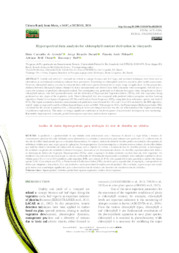Hyperspectral data analysis for chlorophyll content derivation in vineyards.
Hyperspectral data analysis for chlorophyll content derivation in vineyards.
Author(s): ARRUDA, D. C. de; DUCATI, J. R.; PITHAN, P. A.; HOFF, R.
Summary: Quality and yield of a vineyard are related to canopy biomass and leaf vigor, and proximal techniques have been used as alternatives to conventional methods to estimate these parameters. Knowledge on chlorophyll content is crucial to plant health assessments. However, chlorophyll indices can also be extracted from reflectance spectra obtained for an ample range of applications. In this perspective, relations between chlorophyll indices obtained by direct measurements and derived from field radiometry were investigated, with the aim to assess the accuracy of predicted chlorophyll content. The investigation was performed on Cabernet Sauvignon vines, being based on direct chlorophyll surveys, vine leaf spectroradiometry and the derivation of Hyperspectral Vegetation Indices (HVIs), with data acquisition being performed on two stages of the vegetative cycle. Direct chlorophyll data was compared with predicted indices using two machine learning algorithms: Partial Least-Squares Regression (PLSR) and Random Forest Regressor (RFR), using data from reflectance spectra and derived HVIs. The higher correlations between measurements and predictions were obtained for Chl a and Chl a/Chl b modeled by the RFR algorithm, with R2 values as high as 0.8 and Root Mean Squared Errors as low as 0.093. With respect to HVIs, the Photochemical Reflectance Index (PRI) calculated for the second acquisition date, corresponding to leaves reaching senescence was the one which produced the highest percentage of prediction explanations. This study can bring a significant contribution to the development of non-invasive techniques to vine monitoring.
Publication year: 2024
Types of publication: Paper in annals and proceedings
Unit: Embrapa Grape & Wine
Observation
Some of Embrapa's publications are published as ePub files. To read them, use or download one of the following free software options to your computer or mobile device. Android: Google Play Books; IOS: iBooks; Windows and Linux: Calibre.
Access other publications
Access the Agricultural Research Database (BDPA) to consult Embrapa's full library collection and records.
Visit Embrapa Bookstore to purchase books and other publications sold by Embrapa.

